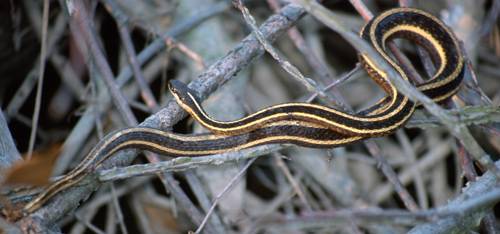The eastern ribbonsnake is a slender snake. It has a dark brown body with 3 yellow or yellow-orange stripes the length of its body. Its belly is yellow to reddish brown. Its tail is long and thin and its head is two-colored with a white area under its eyes and chin. It can be 20 to 32 inches long.
The eastern ribbonsnake ranges from New York to Florida and west to the Mississippi River. There is a western ribbonsnake that can be found further west. In Connecticut the eastern ribbonsnake's distribution is spotty but can occur all over the state. Its population has been in long-term decline and it is a species of Special Concern in Connecticut.
Eastern ribbonsnake habitat is in shallow water, marshy areas, grassy and shrubby areas that border streams and wooded swamps. They can often be seen basking along water's edge. Snakes cannot regulate their body temperature internally and must warm themselves in the sun.
Eastern ribbonsnakes mate in May in New England and females give birth to live young.
These snakes hibernate near streams in the winter from about October to March. They will use muskrat bank burrows or houses, ant mounds, crayfish burrows or vole burrows for dens.
The diet of eastern ribbonsnakes includes insects, salamanders, frogs toads and small fish.
Eastern ribbonsnakes want to avoid humans and their first line of defense is to flee. They may release musk when handled, and rarely may bite. They are not venomous. They are harmless snakes. It's best to leave them in peace.
The eastern ribbonsnake is often confused with the eastern gartersnake.
